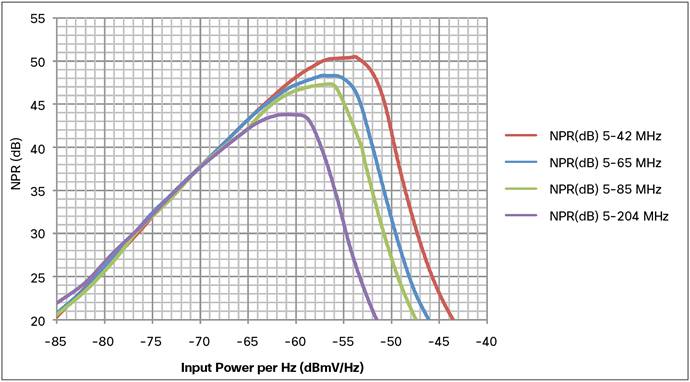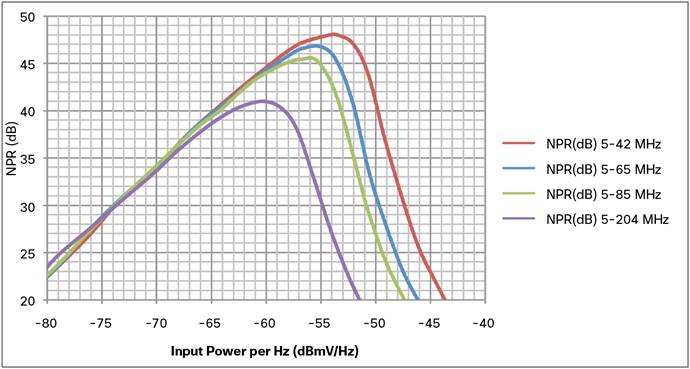The Cisco® Prisma II line of optical network transmission products is an advanced transmission system designed to optimize network architectures and increase reliability, scalability, and cost-effectiveness. The Prisma II Dual Reverse Optical Receiver modules are available in the half-height high-density form factor.
The modules (Figure 1) contain two independent reverse optical receivers and two RF output ports. A single module occupies one slot in a Prisma II XD chassis. Two such modules can be vertically stacked in an associated Prisma II host module that occupies a single-wide slot in the Prisma II standard chassis. Up to 26 Prisma II Dual Reverse Receiver 300MHz modules can operate in a standard 6RU chassis,[1] while up to 16 Prisma Dual Reverse Receiver modules 300MHz can operate in the 3RU Prisma II XD chassis.
The ability to mix high-density receivers with other Prisma II modules in the same chassis greatly enhances the flexibility of the platform. Prisma II Dual Reverse Optical Receiver 300 MHz modules are available in two versions: standard input level and low input level.
Features
● Support of DOCSIS® 3.1 upstream (5 to 300MHz)
● Unique squelch function for radio frequency over glass (RFoG) support (on low input version)
● Blind-mate (push-on) connections for RF, power, and data
● RF test points (one for each independent optical receiver)
● Adjustable RF output levels
● Optical automatic gain control
● Local control through Local Craft Interface (LCI) and/or Intelligent Communications Interface Module (ICIM)
● Remote control and monitoring with web interface and Simple Network Management Protocol (SNMP)
● Primary/secondary or independent mode redundancy
Calculating Reverse Receiver RF Output Level
Use the appropriate formula provided below, to determine the receiver (Rx) RF output level for design purposes.
Table 1. Receiver Output Level Formula
Receiver Type | Output level of receiver |
Prisma II HD Dual Rev Rx, 5–300MHz, Std Input, SA | Uout = 89 + (2 x Pin) + 20 x log(m) [dBmV] |
PrismaII HD Dual Rev Rx, 5–300MHz, Low Input, SA | Uout = 96 + (2 x Pin) + 20 x log(m) [dBmV] |
● Pin is the reverse receiver optical input power, expressed in dBm.
● m is the modulation index per carrier of the optical transmitter feeding the receiver.
(e.g.: OMI=10% => m=0.1)
Alternatively:
Use the appropriate full link gain formula provided in Table 2, along with the following procedures, to determine the receiver (Rx) RF output level for design purposes.
Table 2. Full Link Gain Formula
Receiver Type | Full Link Gain Formula |
Prisma II HD Dual Rev Rx, 5–300MHz, Std Input, SA | 89 – mpeak + (2 x Pin) |
Prisma II HD Dual Rev Rx, 5–300MHz, Low Input, SA | 96 – mpeak + (2 x Pin) |
1. Calculate the full link gain using the appropriate formula in Table 2, where:
● mpeak is the reverse transmitter single carrier wave RF input (drive) level, expressed in dBmV, that produces 100 percent peak optical modulation index (OMI).
● Pin is the reverse receiver optical input power, expressed in dBm.
The resulting full link gain is the gain of the link in dB from the reverse transmitter RF input to the reverse receiver RF output, with receiver output attenuation set to minimum (0 dB).
2. Calculate the usable link gain as follows:
● Add the full link gain to the reverse transmitter maximum expected composite RF input (drive) level to determine the maximum expected Rx composite RF output level.
● Determine if the maximum expected reverse Rx composite RF output level exceeds the maximum RF output level specification.
If the maximum expected reverse Rx composite RF output level exceeds the maximum RF output level specification, calculate the amount of Rx RF attenuation (level reduction in dB) required to prevent such an occurrence. Then calculate the usable link gain using the formula: Usable Link Gain = Full Link Gain – Rx Attenuation.
If maximum expected reverse Rx composite RF output level does not exceed the maximum RF output level specification, then the full link gain is equal to the usable link gain (no Rx attenuation required).
3. Calculate the receiver RF output level as follows:
● Rx RF Output Level = Tx Design RF Input Level + Usable Link Gain
This formula yields the RF output level that can be used for reverse RF design in the headend or hub site where the receiver is located.
Note:
Many systems are designed for a common Rx RF output level by first calculating output level for the links with greatest optical loss. For links with lower optical loss, Rx RF attenuation is then added (2 dB for each dB lower optical link loss) to achieve the common Rx RF output level.
Product Specifications
Tables 3 through 9 provide specifications for the Cisco Prisma II Dual Reverse Optical Receivers 300 MHz.
Table 3. Optical Specifications
Feature | Units | Standard Input | Low Input | Notes |
Input power | dBm | –18 to +2 | –25 to –10 |
|
Wavelength | nm | 1260 to 1620 | 1260 to 1620 |
|
Optical return loss | dB | > 40 | > 40 |
|
Optical interface: |
| SC/APC | SC/APC |
|
Table 4. Electrical Specifications
Feature | Units | Standard Input | Low Input | Notes |
RF bandwidth | MHz | 5 to 300 | 5 to 300 |
|
RF output level | dBmV | Use RF output level calculations (see Tables 1 and 2) | Use RF output level calculations (see Tables 1 and 2) |
|
Maximum RF output level | dBmV | 60 (composite) | 60 (composite) | 1 |
RF attenuation range | dB | 0 to 30 in 0.5 dB steps | 0 to 30 in 0.5 dB steps | 2 |
Optical AGC range | dB | 15 | 15 | 3 |
Module responsivity | A/W dB | ≥ 537 | ≥ 1202 | 4 |
Noise Power Ratio |
| See curve | See curve | figure 2, 3 |
RF frequency response | dB | ±0.5 | ±0.5 | 5 |
RF test point | dB | -20 (±0.75) | –20 (±0.75) |
|
Return loss | dB | > 18 | > 18 |
|
Output Tilt (typ./max.) | dB | +1.5 (±0.5 / ±0.75) | +1.5 (±0.5 / ±0.75) | 6 |
Noise Equivalent Power (typ./max.) | pA/√Hz | 2.0 / 2.5 | 1.1 / 1.4 | 6 |
Power Consumption | W DC | < 5 | < 5.5 |
|
Notes:
1. Reverse receiver (Rx) maximum output level is determined using 5 to 204 MHz loading while ensuring that the link noise power ratio (NPR) dynamic range is not Rx limited. Rx RF attenuation may be needed to avoid exceeding maximum Rx output level in operation. (See the Calculating Reverse Receiver RF Output Level section of this data sheet).
2. RF attenuation control: software control is through LCI, ICIM, or web interface.
3. Optical automatic gain control (AGC) range above and below nominal optical input power is determined by the initial RF attenuation setting.
4. Module responsivity is measured at 1310 nm with 0 dB RF attenuation, and may change at other wavelengths.
5. The RF frequency response is with tilt subtracted.
6. Value is typical for room temperature, while maximum for over temperature.
Unless otherwise noted, specifications reflect typical performance and are referenced to the ambient air temperature at the inlet to the Prisma II standard or Prisma II XD chassis. Specifications are based on measurements made according to SCTE/ANSI standards (where applicable), using standard frequency assignments.
Note:
Noise power ratio (NPR) dynamic range (DR) is measured at -8dBm optical input power for the standard input version and – 13dBm optical input power for the low input version (combination of respectively 15km and 25 km fiber and passive loss of respectively 13dB and 10dB attenuation in the receiver module). NPR DR is measured with full band noise loading with a notch filter in the center of the respectively band. The reverse transmitter used for NPR testing is Cisco GS7000 High gain Rev Tx, CWDM (1550nm).
Table 5. Squelch Specification (Only on Prisma II HD Dual Rev Rx, 5-300MHz, Low Input, SA)
Feature | Units | Low Input |
Receiver turn-on time | µs | < 0.5 |
Receiver turn-off time | µs | < 1.2 |
Table 6. Environmental Specifications
Feature | Units | Standard Input | Low Input |
Temperature range, full specifications and operational | °C | 0 to +50 | 0 to +50 |
Humidity range | % | 0 to 95 | 0 to 95 |
Table 7. Mechanical Specifications
Feature | Units | Standard Input | Low Input |
Depth | in. cm | 8.8 22.4 | 8.8 22.4 |
Width | in. cm | 1.03 2.6 | 1.03 2.6 |
Height | in. cm | 3.5 8.8 | 3.5 8.8 |
Weight | kg | 0.9 0.4 | 0.9 0.4 |
Module width | slots | 1 | 1 |
Ordering Information
To place an order, visit the Cisco Ordering homepage and refer to Table 10.
Table 8. Ordering Information
Description | Part Number |
Prisma II HD Dual Rev Rx, 5-300MHz, Std Input, SA | P2-RRX-STD |
Prisma II HD Dual Rev Rx, 5-300MHz, Low Input, SA | P2-RRX-LIN |
Service and Support
Using the Cisco Lifecycle Services approach, Cisco and its partners provide a broad portfolio of end-to-end services and support that can help increase your network’s business value and return on investment. This approach defines the minimum set of activities needed by technology and by network complexity to help you successfully deploy and operate Cisco technologies and optimize their performance throughout the lifecycle of your network.
For More Information
Cisco Prisma II products provide one of the industry’s most complete ranges of high-performance optical components. To learn more about Cisco Prisma II Dual Reverse Optical Receivers 300MHz, please consult with your account representative, customer service representative, or systems engineer to determine the best configuration for your particular application.






